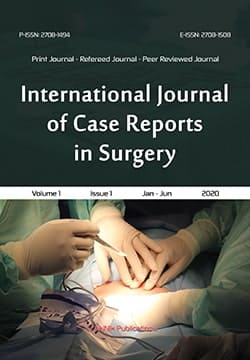Printed Journal | Refereed Journal | Peer Reviewed Journal
Peer Reviewed Journal
2025, Vol. 7, Issue 2, Part C
Role of local flaps in soft tissue reconstruction of upper limbs following blast injuries: Experience from Ghazi Al-Hariri Hospital for Surgical Specialties, Baghdad Medical City
Author(s): Fatimah Ghalib Mahdi Al-Najjar
Abstract: Blast injuries remain a devastating and persistent consequence of decades of armed conflict in Iraq, with the upper extremity frequently sustaining complex, high-energy soft tissue defects that threaten limb viability and functional independence. At Ghazi Al-Hariri Hospital for Surgical Specialties (GAHHSS) the premier tertiary referral center for trauma and reconstructive surgery within Baghdad Medical City local flaps have been systematically employed as a pragmatic, cost-effective, and reliable reconstructive modality in a setting characterized by limited resources, high patient volume, and constrained access to microsurgical infrastructure. This retrospective cohort study analyzes the clinical outcomes of 112 consecutive patients who underwent upper limb soft tissue reconstruction using local flaps following blast injuries between January 2017 and December 2023. Data on patient demographics, injury characteristics, flap type, defect size and location, complications (including infection, partial or total flap necrosis, and wound dehiscence), functional recovery (assessed via the validated Arabic version of the Disabilities of the Arm, Shoulder and Hand [DASH] questionnaire), and resource utilization were meticulously collected and analyzed. The cohort comprised predominantly young male civilians (mean age: 27.6 years; 92% male), with improvised explosive devices (IEDs) accounting for 69.6% of injuries. Defects most commonly involved the dorsum of the hand (33%) and forearm (28%), with 92.0% exposing critical structures such as tendons or bone. A total of eight local flap techniques were utilized, guided by a standardized institutional algorithm based on anatomic zone and defect dimensions. The overall flap survival rate was 91.1% (102/112), with partial necrosis in 6.3% and total loss in 2.7%. The mean DASH score improved significantly from 28.4 at 3 months to 19.1 at 6 months postoperatively, and 67.9% of patients returned to work or daily activities within six months. Notably, local flaps reduced operative time by 74% and per-case costs by 85% compared to free tissue transfer, while eliminating the need for intensive care unit (ICU) admission in the majority of cases. This comprehensive, single-center Iraqi experience underscores the indispensable role of local flaps in achieving durable, functional, and aesthetically acceptable limb salvage in the aftermath of blast trauma. The findings advocate for the integration of structured, anatomy-based local flap protocols into national trauma reconstruction guidelines across conflict-affected and resource-limited regions.
DOI: 10.22271/27081494.2025.v7.i2c.215
Pages: 154-165 | Views: 67 | Downloads: 27
Download Full Article: Click Here

How to cite this article:
Fatimah Ghalib Mahdi Al-Najjar. Role of local flaps in soft tissue reconstruction of upper limbs following blast injuries: Experience from Ghazi Al-Hariri Hospital for Surgical Specialties, Baghdad Medical City. Int J Case Rep Surg 2025;7(2):154-165. DOI: 10.22271/27081494.2025.v7.i2c.215








